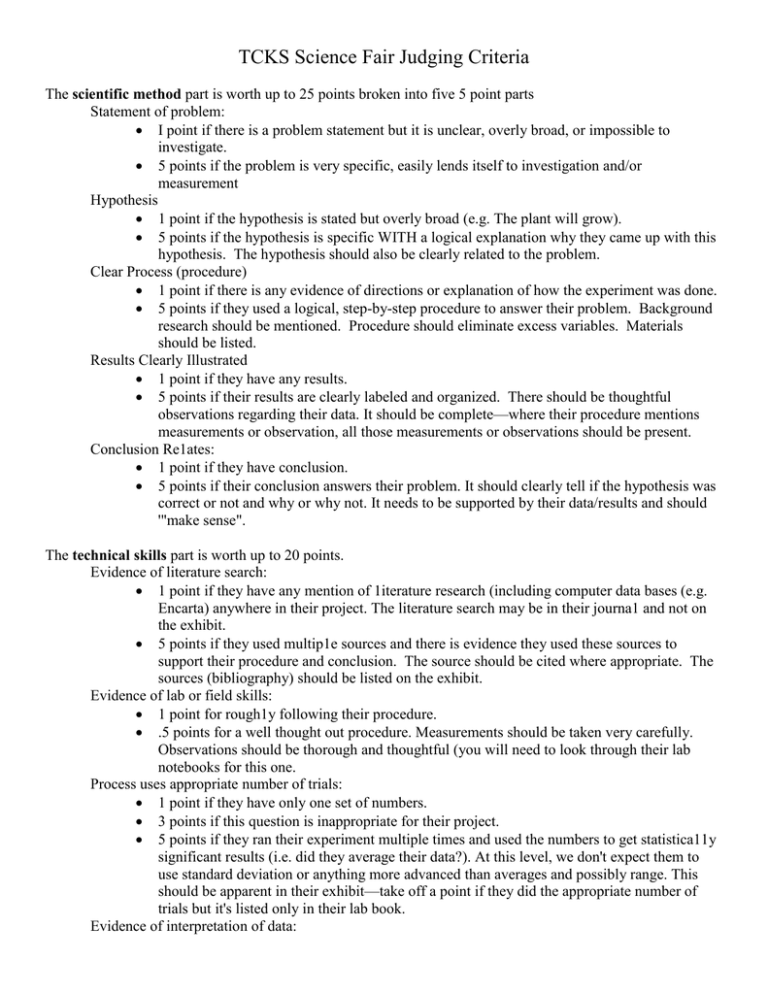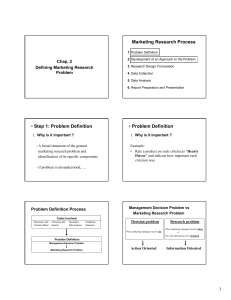TCKS Science Fair Judging Criteria
advertisement

TCKS Science Fair Judging Criteria The scientific method part is worth up to 25 points broken into five 5 point parts Statement of problem: I point if there is a problem statement but it is unclear, overly broad, or impossible to investigate. 5 points if the problem is very specific, easily lends itself to investigation and/or measurement Hypothesis 1 point if the hypothesis is stated but overly broad (e.g. The plant will grow). 5 points if the hypothesis is specific WITH a logical explanation why they came up with this hypothesis. The hypothesis should also be clearly related to the problem. Clear Process (procedure) 1 point if there is any evidence of directions or explanation of how the experiment was done. 5 points if they used a logical, step-by-step procedure to answer their problem. Background research should be mentioned. Procedure should eliminate excess variables. Materials should be listed. Results Clearly Illustrated 1 point if they have any results. 5 points if their results are clearly labeled and organized. There should be thoughtful observations regarding their data. It should be complete—where their procedure mentions measurements or observation, all those measurements or observations should be present. Conclusion Re1ates: 1 point if they have conclusion. 5 points if their conclusion answers their problem. It should clearly tell if the hypothesis was correct or not and why or why not. It needs to be supported by their data/results and should '"make sense". The technical skills part is worth up to 20 points. Evidence of literature search: 1 point if they have any mention of 1iterature research (including computer data bases (e.g. Encarta) anywhere in their project. The literature search may be in their journa1 and not on the exhibit. 5 points if they used multip1e sources and there is evidence they used these sources to support their procedure and conclusion. The source should be cited where appropriate. The sources (bibliography) should be listed on the exhibit. Evidence of lab or field skills: 1 point for rough1y following their procedure. .5 points for a well thought out procedure. Measurements should be taken very carefully. Observations should be thorough and thoughtful (you will need to look through their lab notebooks for this one. Process uses appropriate number of trials: 1 point if they have only one set of numbers. 3 points if this question is inappropriate for their project. 5 points if they ran their experiment multiple times and used the numbers to get statistica11y significant results (i.e. did they average their data?). At this level, we don't expect them to use standard deviation or anything more advanced than averages and possibly range. This should be apparent in their exhibit—take off a point if they did the appropriate number of trials but it's listed only in their lab book. Evidence of interpretation of data: 1 point if there’s any interpretation, no matter how poorly done. 5 points if their interpretation is logically tied to their data. They shouldn’t have ignored any data or used data that isn't on their exhibit The Display of Project part is also worth a maximum of 20 points. Complete scientific method: 5 points if the following 5 steps are in the correct order: o Statement of problem o Hypothesis o Procedure o Results o Conclusion Take off 1 point for each step that is, missing. Take off 1 point if some are out of order. However, give the student some leeway in designing the layout of the exhibit. The steps should be easy to follow. Concise descriptions: 1 point if the descriptions are hard to read due to grammar. 5 points if they are easy to read and to the point. Neat, easy to read, spelling: I point if you can barely read it with a lot of misspellings. 5 points if very neat, no misspellings. Do NOT take off points if the project is hand printed rather than typed or computer generated. Creativity in design of display: Most projects should get 3 here unless the layout is extremely hard to follow or the student has done something exceptional on the layout that gets your attention. The Creative Ability in Project part is worth a maximum of 10 points. Imagination in selection of problem: Is this a project you’ve never seen before? Interesting? Then 5 points. Or are there half a dozen other projects with nearly the same problem? Then give them 2 or 3 points. Give them 1 point if the problem was chosen for them (Although I doubt if any of them would admit this on the exhibit itself). Creativity in experimenta1 approach: Did the student have a unique method in their procedure or come up with an interesting way to get around a problem? If so then 5 points is appropriate. 3 points if the procedure is pretty much run of the mill. 1 point if it is obvious the student followed a manual with no changes.





